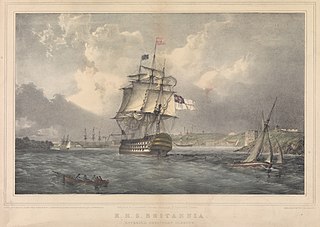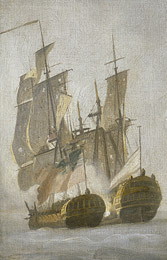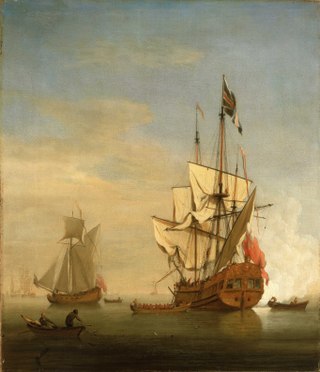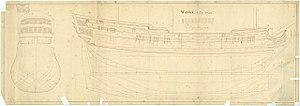
HMS Britannia, also known as Old Ironsides, was a 100-gun first-rate ship of the line of the Royal Navy.

HMS Ocean was a 90-gun second rate ship of the line of the Royal Navy, launched on 21 April 1761 at Chatham.

HMS Europa was a 64-gun third rate ship of the line of the Royal Navy, launched on 21 April 1765 at Lepe, Hampshire. She was renamed HMS Europe in 1778, and spent the rest of her career under this name.

The Foudroyant was an 80-gun ship of the line of the French Navy. She was later captured and served in the Royal Navy as the Third Rate HMS Foudroyant.

HMS Modeste was a 64-gun third rate ship of the line of the Royal Navy. She was previously the 64-gun Modeste, of the French Navy, launched in 1759 and captured later that year.

HMS Captain was a 70-gun third rate built at Woolwich Dockyard in 1677/78. After sitting in Ordinary for ten years she was in active commission for the War of the English Succession fighting at Beachy Head and Barfleur. She was in Ordinary until 1706 when she was rebuilt. She was in active commission for the last half of the War of Spanish Succession but fought in no major engagements. She was at the Battle of Passero I 1718. She was rebuilt in 1720/22. She made two forays in to the Baltic though the bulk of her late career was spent as guardship at Portsmouth. She was hulked in 1740 and finally broken in 1762.

HMS Lenox was a 70-gun third rate built at Deptford Dockyard in 1677/78. She was in active commission for the War of English Succession fighting in the Battles of Beachy Head and Barfleur. She was rebuilt in 1699. Again in active commission for the War of Spanish Succession fighting in the Capture of Gibraltar and the Battle of Velez Malaga. She followed this with the Battle off Passero. She was rebuilt again in 1721. She was active in the War with Spain, capturing the Princesa then serving in Home Waters, the Mediterranean and finally the West Indies. She was in action off Havana in 1745. She returned home and was placed in Ordinary. She was finally sunk as a breakwater at Sheerness in 1756.

HMS Essex was a 70-gun third rate built by Sir Henry Johnson of Blackwall in 1678/79. During the War of the English Succession she fought in the last major action. She was rebuilt in 1699/1700. During the War of Spanish Succession she fought at Vigo Bay, the Capture of Gibraltar and Velez Malaga. She also fought at the Battle off Passero in 1718. She was rebuilt again in 1736-40. She was in action off Toulon in 1744. She was active in the Channel and against French ports during the Seven Years War. She fought at Quiberon Bay in 1759. She was wrecked in Quiberon Bay in November 1759.

HMS Expedition was a 70-gun third-rate ship of the line built at Portsmouth Dockyard in 1677/79. She was in active commission during the War of the English Succession participating in the battles of Beachy Head and Barfleur. She was rebuilt in 1699. Again, for the War of Spanish Succession she was in commission for the operation at Cadiz then returned to England where she sat for two years. She was in the Mediterranean for the Battle of Marbella in 1705. She then went to the West Indies and fought in Wager's action off Cartagena in 1708. She was rebuilt in 1709-14 to the 1706 Establishment. She spent her time split between the Baltic and as guard ship at Portsmouth before being broken at Portsmouth in 1736. She was rebuilt in 1736/40 at Deptford Dockyard.

HMS Burford was a 70-gun third rate ship of the line of the Royal Navy, built at Deptford Dockyard to the 1719 Establishment, and launched on 19 July 1722. Burford was notably the early posting of both John Forbes and John Byng, both of whom rose to become admirals.

HMS Weymouth was a 60-gun fourth rate ship of the line of the Royal Navy, launched in 1736 and in service during the War of the Austrian Succession. Initially stationed in the Mediterranean, she was assigned to the Navy's Caribbean fleet in 1740 and participated in Battle of Cartagena de Indias in 1741. Decommissioned later that year, she was restored to active service in the Caribbean in 1744. A navigational error on 16 February 1745 brought her too close to the shore of Antigua, where she was wrecked upon a submerged reef. Three of Weymouth's officers were subsequently found guilty of negligence, with two required to pay substantial fines and the third sentenced to a two-year jail term.

HMS Minerva was one of the four 32-gun Southampton-class fifth-rate frigates of the Royal Navy. She was launched in 1759 and served through the Seven Years' War, but was captured in 1778 during the American Revolutionary War and served as the French Minerve until being recaptured in 1781 and renamed HMS Recovery. She was broken up in 1784.

HMS Peregrine Galley was a 20-gun sixth-rate ship of the Royal Navy, built in 1699-1700 at Sheerness Dockyard by Master Shipwright William Lee to a design by Rear-Admiral the Marquis of Carmarthen. She was generally employed as a Royal yacht and in 1716 she was officially renamed HMS Carolina and converted to a permanent Royal yacht. In May 1733 she was rebuilt by Richard Storey at Deptford Dockyard as the Royal yacht and again renamed, this time as Royal Caroline. In 1739 she ceased to be the Royal yacht and resumed her classification as a Sixth Rate. In 1749 a new Royal Caroline was built to replace her. She reverted to being a naval sloop under the name HMS Peregrine and served until her loss on or about 28 December 1761.
HMS Shoreham was a 32-gun fifth rate vessel built under contract at Shoreham in 1693/94. During the War of the English Succession she was involved in the unsuccessful operation at Camaret Bay. At the end of the war she helped take half a French convoy off Ireland. She then deployed to North America and the West Indies. She was rebuilt as a 20-gun sixth rate to the 1719 Establishment in 1719/21. She served in the Baltic as a bomb vessel then reverted to a sixth rate. She participated in operations in the West Indies during the initial years of the War of Austrian Succession before being sold in 1744.
HMS Lyme was a 32-gun fifth rate built by Mr. Flint of Plymouth in 1694/95. She spent her career on counter piracy patrols and trade protection duties in Home Waters, the Mediterranean and in North America and the West Indies. She was rebuilt to the 1719 Establishment as a sixth rate in 1720/21. Her breaking was completed in January 1739.
HMS Scarborough was a 32-gun fifth rate built under contract by James Parker of Southampton in 1695/96. She served in the trade protection and counter-piracy operations during her service. She was captured by the French, then recaptured by the British and renamed Garland, She was converted to a fireship for the Baltic then the Mediterranean. She was at the Battle of Passero in 1718. She was reduced to a 20-gun sixth rate in 1717. Rebuilt to the 1719 Establishment in 1721, she was finally sold in 1744.
HMS Poole was a 32-gun fifth rate built by Joseph Nye & George Moore of East Cowes on the Isle of Wight in 1695/96. She spent the first part of her career on trade protection and counter piracy patrols. After 1719 she was converted to a fireship. She was finally sunk as a breakwater at Harwich in July 1737.
HMS Lowestoffe was a 32-gun fifth rate built at Chatham Dockyard in 1696/97. She spent her career on counter piracy patrols and trade Protection duties. She participated in the capture of Port Royal in Nova Scotia. She was rebuilt in 1722/24 as a 20-gun sixth rate. She was sold in July 1744.
HMS Tartar was a 32-gun fifth rate built by the Woolwich Dockyard in 1702. Her initial commissioning was in time for the War of the Spanish Succession. She partook in the Battle of Velez Malaga in 1704. She spent the rest of her career on counter piracy and trade protection patrols. She was rebuilt as a 20-gun sixth rate in 1733. She was finally broken in 1755.
Rear-Admiral Polycarpus Taylor was a Royal Navy officer of the eighteenth century, most notable for his service commanding ships in the West Indies during the War of the Austrian Succession. Having joined the Royal Navy some time before 1733, Taylor then served at the Battle of Cartagena de Indias and Invasion of Cuba before being promoted to commander in 1742. After commanding several vessels and being promoted to post-captain, in August 1744 Taylor took command of HMS Fowey; serving in the English Channel he ran ashore and destroyed the French privateer Griffon in 1745.














